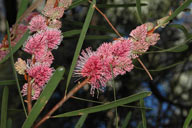Information about plants in flower this week
A news sheet prepared by a Gardens' volunteer, featuring the flowers, fruits and foliage of a selection of plants in
the Australian National Botanic Gardens .
Numbers before each plant refer to temporary IFTW labels in the gardens.
Numbers in square brackets [ ] refer to garden bed Sections. Featured plants are in bold type.
View past issues of 'In Flower This Week'.
17 - 30 August
|
Hakea 'Winter Burgundy' click for larger image |
Today we will walk from the Visitor Information Centre (VIC) up the Main Path to see the winterflowering grevilleas.
- Look left as you leave the VIC to see in a pot Homoranthus thomasii [Section 221], a small bush with grey-green leaves, dark red stems and tiny red bell flowers with white tips. This plant is found in inland central Queensland.
- Go across the bridge, past the café and up the hill on the Main Path to see on your left Acacia baileyana (prostrate form) [Section 30], or Cootamundra Wattle, with bright gold balls of flower on drooping greygreen fringed foliage. The species is endemic to New South Wales but is widely cultivated and has become naturalised as a weed elsewhere in Australia and overseas.
- Further on your right is Homoranthus flavescens [Section 30], with acid yellow blooms layered on a small neat bush. There is a pretty contrast between the yellow blooms and the fresh green needle foliage.
- Low on your right is Grevillea acropogon [Section 30], a low bush with green foliage and deep red clusters of flowers. It is endemic to southwestern Western Australia and is threatened in the wild.
- Grevillea saccata [Section 30], in a pot on your right, has weeping branches with bright green upright leaves and pinkish-orange flowers. This shrub is commonly known as Pouched Grevillea, and is endemic to southwestern Western Australia.
- Grevillea sericea subsp. sericea [Section 27], on your right, is an airy bush with light green foliage and white spider flowers. This plant occurs naturally west of Sydney.
- Grevillea 'LadyO' [Sections 24 and 26], across the road on the left and right, is a long-blooming shrub with red flowers and bright green foliage. 'LadyO' is a cross between Grevillea rhyolitica and a hybrid involving Grevillea victoriae. This cultivar was developed by local plant breeder Peter Ollerenshaw and named for his mother.
- On your right is Hakea 'Winter Burgundy' [Section 26], a tall upright bush with greygreen leaves and bright burgundy blooms.
- Grevillea lavandulacea [Section 26], also on your right, commonly known as Lavender Grevillea, is found in southeastern South Australia and western and central Victoria. The shrub shows a pleasing contrast between the grey foliage and dark red flowers.
- Grevillea speciosa [Section 26], on your right, also known as Red Spider Flower, is a shrub which is endemic to New South Wales. It has bright red terminal clusters of flowers on a neat bush of green foliage.
- Grevillea manglesii subsp. manglesii [Section 24], or Birdsfoot Grevillea, on your left is a large open bush with white "pincushion" flower heads all along the stems. It is native to Western Australia.
- Grevillea wilsonii × tripartita [Section 24], is on your left, a tall, rangy bush with prickly green foliage and large red and cream spider flowers with red styles.
- Grevillea tripartita subsp. macrostylis [Section 24], on the left, is an open, rangy plant with dark green, prickly, three-lobed foliage and large single pink and cream flowers with long showy red styles. It is native to southern Western Australia.
- Grevillea ripicola [Section 24], on the left, commonly known as Collie Grevillea, is a shrub endemic to south-west Western Australia. It forms a dense bush with large orange-red spider flowers with red styles.
- Grevillea centristigma [Section 26], on your right, is a small bush with soft lush green foliage fringed with white hairs. Pendent hard yellow/orange flowers open from greenish buds. It is endemic to southwestern Western Australia.
Rosalind Walcott
![Director of National Parks [logo]](../../../../images/dnp_90px.gif)







